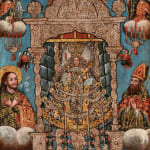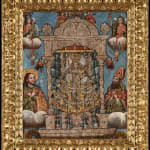OUR LADY OF COPACABANA
Provenance
Private collection
The work we have before us here is a beautifil portait of the most famous mestizo Virginal advocation in the Peruvian Viceroyalty, and one of the most popular ones throughout South America, Our Lady of Copacabana.
Worship of Our Lady was started in 1584, in the town of Copacabana, on the shores of Lake Titicaca in the remains of an old Incan temple, by Francisco Tito Yupanqui, an indigenous Bolivian and devotce of the Virgin." From that point on, her image was repeatedly reproduced thanks to the paradigmatic process of religious syncretism which, through efforts using art to reconvert and superimpose, successfully incorporated pre-existing myths and beliefs into the models set out by the Catholic Counter Reformation. Following her initial exaltation, the popularity of Our Lady of Copacabana spread both inside the American continent and beyond, thanks to the numerous miracles associated with her image. Strategically disseminated by the most efficient means available at the time, the superstitious aura enveloping the image of the Virgin gave rise to an enormous artistic repertoire filling the walls of houses, palaces and churches with paintings and sculptures.
Looking at the way the iconography of this revered Marian figure evolved, we see how depictions of her, following a process involving the devotional redefining of Pre-Hispanic icons, were no more than an adaptation of the Virgin of Candelaria, to which her own attributes and meanings were ascribed. Our Lady appears enthroned within a structure simulating silver, supported on four Solomonic columns over which there is a keel arch pediment. This is topped by a semi-circular crown with phytomorphic decorations, presided over by a scallop shape of the same fattura as two others located on the top corners of he pediment. This odd way of arranging the Virgin, within a throne structure made to look like silver, is evidence of the influence of Luis Niño's, a multi-faceted Bolivian artist who was particularly skilled at depicting silver objects. On the throne we see Our Lady, elegantly dressed in a bell-shaped cloak, clearly a syncretic allusion to Pachamama. The Virgin's robe is presented as a sort of horror vacui, replete with embroidery, pearly decorations, precious stones and ornate giltwork, with the same appearance and elegance as the imperial crown sitting above her mystical oval face. The Infant Christ is cradled on her left arm, while her right hand holds a candle which, along with the four candlesticks arranged at the base of the throne, symbolize Marian purification, the origin of the advocation resulting in this mestizo representation, the Virgin of Candelaria.
Literature



